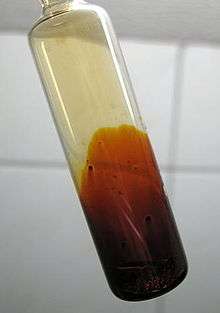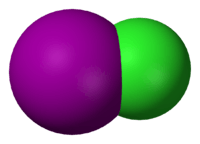Iodine monochloride
| |||
 | |||
| Names | |||
|---|---|---|---|
| Preferred IUPAC name
Iodine monochloride Iodine(I) chloride | |||
| Systematic IUPAC name
Chloroiodane | |||
| Other names
Iodine chloride | |||
| Identifiers | |||
| 7790-99-0 | |||
| 3D model (Jmol) | Interactive image | ||
| ChemSpider | 23042 | ||
| ECHA InfoCard | 100.029.306 | ||
| EC Number | 232-236-7 | ||
| MeSH | Iodine-monochloride | ||
| PubChem | 24640 | ||
| UN number | 1792 | ||
| |||
| |||
| Properties | |||
| ICl | |||
| Molar mass | 162.35 g/mol | ||
| Appearance | blue and yellow | ||
| Density | 3.10 g/cm3 | ||
| Melting point | 27.2 °C (81.0 °F; 300.3 K) (α-form) 13.9 °C (β-form) | ||
| Boiling point | 97.4 °C (207.3 °F; 370.5 K) | ||
| hydrolysis | |||
| Solubility | soluble in CS2 acetic acid pyridine alcohol, ether, HCl | ||
| Hazards | |||
| Main hazards | corrosive | ||
| Safety data sheet | External MSDS | ||
| Related compounds | |||
| Related interhalogen compounds |
Chlorine monofluoride Bromine monochloride Iodine monobromide | ||
| Except where otherwise noted, data are given for materials in their standard state (at 25 °C [77 °F], 100 kPa). | |||
| | |||
| Infobox references | |||
Iodine monochloride is an interhalogen compound with the formula ICl. It is a red-brown chemical compound that melts near room temperature. Because of the difference in the electronegativity of iodine and chlorine, ICl is highly polar and behaves as a source of I+. Owing to the similarity of the properties of the compound with bromine (red-brown liquid at room temperature), its synthesis led early researchers to believe that the reaction between the heaviest and lightest of a 'triad' of elements (three elements with similar chemical properties, now found in the same group of the modern periodic table) would produce the central element of the triad, the so-named 'Law of Averages'.
Iodine monochloride is produced simply by combining the halogens in a 1:1 molar ratio, according to the equation
- I2 + Cl2 → 2 ICl
When chlorine gas is passed through iodine crystals, one observes the brown vapor of iodine monochloride. Dark brown iodine monochloride liquid is collected. Excess chlorine converts iodine monochloride into iodine trichloride in a reversible reaction:
- ICl + Cl2 ⇌ ICl3
Polymorphs
ICl has two polymorphs; α-ICl, which exists as black needles (red by transmitted light) with a melting point of 27.2 °C, and β-ICl, which exists as black platelets (red-brown by transmitted light) with a melting point 13.9 °C.[1]
In the crystal structures of both polymorphs the molecules are arranged in zig-zag chains. β-ICl is monoclinic with the space group P21/c.[2]
Uses
ICl is a useful reagent in organic synthesis.[1] It is used as a source of electrophilic iodine in the synthesis of certain aromatic iodides.[3] It also cleaves C-Si bonds.
ICl will also add to the double bond in alkenes to give chloro-iodo alkanes.
When such reactions are conducted in the presence of sodium azide, the iodo-azide RCH(I)-CH(N3)R’ is obtained.[4]
Wijs solution, which is iodine monochloride dissolved in acetic acid, is used to determine the iodine value of a substance.
It can also be used to make pure iodates, by reacting with a chlorate and releasing chlorine gas as byproduct
References
- 1 2 Brisbois, R. G.; Wanke, R. A.; Stubbs, K. A.; Stick, R. V. "Iodine Monochloride" Encyclopedia of Reagents for Organic Synthesis, 2004 John Wiley & Sons. doi:10.1002/047084289X.ri014
- ↑ Carpenter, G. B.; Richards, S. M. (1 April 1962). "The crystal structure of β-iodine monochloride". Acta Crystallographica. 15 (4): 360–364. doi:10.1107/S0365110X62000882.
- ↑ Wallingford, V. H.; Krüger, P. A. (1943). "5-Iodo-anthranilic Acid". Org. Synth.; Coll. Vol., 2, p. 349
- ↑ Padwa, A.; Blacklock, T.; Tremper, A. "3-Phenyl-2H-Azirine-2-carboxaldehyde". Org. Synth.; Coll. Vol., 6, p. 893

